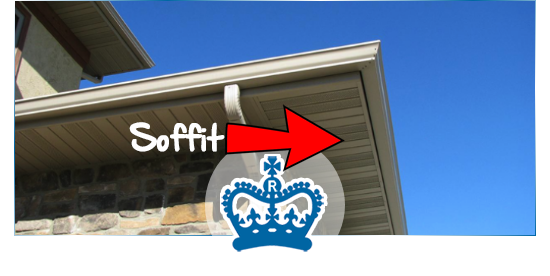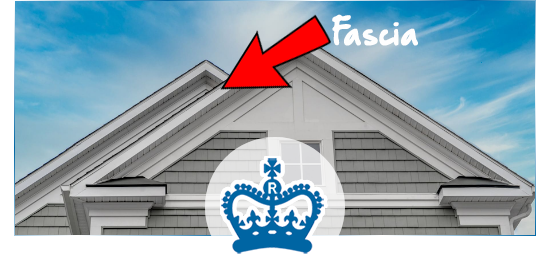


When most of us think of our home exterior, we usually consider the bigger picture – windows, siding, doors. However, soffit and fascia are small details that make quite the difference to your home’s curb appeal and overall comfort. So what is soffit and fascia on a house and why do they matter?
Let’s discuss soffit and fascia and why they’re just as important as anything else on your home.
A soffit is the visible horizontal underside of an architectural element, often found under the eaves of a roof. It connects the fascia (the vertical board at the roof's edge) to the exterior wall of a building. Soffits can be decorative, but they also play a functional role in ventilating attics and protecting the roof structure from weather damage.

Typically, soffit is located on the underside of your roof and is often not visible in terms of curb appeal. It can be seen when you’re close to the home and when you’re underneath it or at street level. Soffit is usually the same design and color as your home’s siding, but can be different depending on your own personal tastes and preferences.
Soffit can be made from wood, aluminum or vinyl. It's important that you have a soffit material suitable for the climate you live in.
Vinyl soffit has all the same characteristics as vinyl siding, so you know your home will be protected with it and look great at the same time.
Although soffit siding and fascia roof elements often work together, they have different purposes and characteristics.
Function:
Soffit: Provides ventilation for your attic, prevents moisture buildup, and blocks animals and insects from entering.
Fascia: Supports the edge of the roof and holds up the gutters. Also contributes to overall curb appeal.
Location:
Soffit: Installed on the underside of the roof overhang.
Fascia: Located at the front-facing edge of the roof above the soffit.
Materials:
Soffit and Fascia: Commonly made of wood, aluminum, or vinyl. Vinyl is best for some environments due to its durability and resistance to moisture and pests.
Common Problems:
Soffit: Susceptible to cracks, holes, or blocked vents, which can allow mold or pests into the attic.
Fascia: Can warp, rot, or become damaged from water if gutters are clogged or improperly maintained.
Installation:
What installs first? Typically, fascia is installed before the soffit. The fascia board creates the framework that the soffit then fits into.
Replacement:
Can you replace a soffit without removing fascia? In most cases, no. Because the fascia forms the outer edge that the soffit tucks into, the fascia often needs to be removed or loosened first to access the soffit beneath it.
Fascia on a roof is the vertical board that runs along the lower edge of the roofline, directly below the roofing and where the roof meets the exterior wall. It acts as a trim piece, providing a finished look and also serving as a support for gutters. Fascia also helps to seal off the roof edge, preventing water, insects, and other elements from getting into the attic space.

Fascia goes hand-in-hand with your home's soffit. Fascia is the area of siding directly above the soffit. It's the exposed board you see on the front of your roof's overhang.
Your fascia is also where gutters are placed. Fascia is very visible and needs to be in good shape so your home's curb appeal isn't in jeopardy.
Just like soffit, fascia can be made of aluminum, wood or vinyl.
Why does soffit and fascia matter? These components may seam small, but they are essential to maintaining a well-functioning and efficient home.
Why Is Soffit Important?
Soffit is important because it has venting that helps keep a steady airflow between your roof and attic. You're probably thinking, why do I want outside air in my home?
Your attic needs to be well ventilated or else moisture can build up causing mold to form. The last thing you want in your home is mold.
Aside from keeping moisture out, soffit helps release heat from your attic during the hot summer months.
Soffit also helps keep animals and insects out of your home. Bees and wasps love to nestle up in soffit, so you need to keep it maintained to prevent them from invading. It's important to make sure your soffit has no cracks or holes in it and if it does, you must repair or replace it right away.
Why Is Fascia Important?
Fascia consists of the long straight board along the lower edge of the roof, so how can it be so important? For starters, it's the last line of support for the lower edge of the bottom row of roof tiles or shingles.
Plus, it's what your gutters are installed on. Gutters are extremely important and your fascia needs to be able to hold them up even during torrential downpour.
Fascia is also important because it's visible to everyone. If you want to maximize your home's curb appeal, your fascia needs to look great as well.
Advantages of Vinyl Soffit and Fascia
Choosing the right materials for your soffit and fascia can save you time, money, and stress in the long run. Here's why vinyl is the superior option for most homeowners:
In short, vinyl soffit and fascia are great solutions for long-lasting protection and style. If your soffit or fascia looks worn, now is the time to upgrade with durable, energy-efficient materials from Royal Peaks Roofing.
